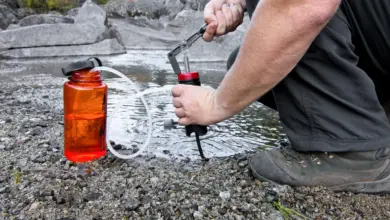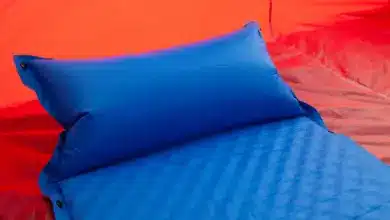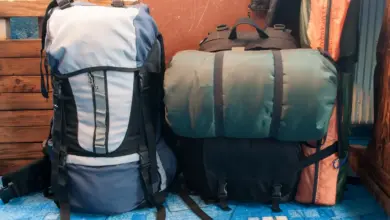How To Make Your Winter Sleep System: Complete Guide
How To Make Your Winter Sleep System: Complete Guide
Choosing a winter sleeping bag is even more critical in winter. Before you go out and buy the warmest sleeping bag you think you’ll need, there are some questions that should be answered. How important is weight? If you are trying to save ounces with a sleeping bag, you may make some sacrifices. How warm do you like to sleep? Some people sleep better in the cold, others do not. What about the environment, will it be wet or dry? Will you be in dry or wet environments? These are all questions to ask yourself before buying a sleeping bag for winter.
Here are some sleeping bag features to look for:
Choosing a winter sleeping bag
How warm a sleeping bag will be will depend on the thickness of the fill. The thickness of the fill will create dead air space, trapping warm air. The thicker the fill, the more dead space there will be.
Fills
The warmest winter sleeping bags per weight are made from goose down. Goosedown provides 1/3 more insulation compared to high-tech synthetic fibers. This means you will get 1/3 more warmth for the same weight, or 1/3 less weight for the same warmth. Another benefit of goose-down sleeping bags is that they compress more than other bags, adding less bulk to your trip. If goose-down bags are maintained properly, they can last twice as long.
With all the benefits of goose down, there are some drawbacks to consider. Down absorbs moisture quickly. If the down gets wet, the loft collapses and will no longer retain heat. Moisture does not only come from the elements such as snow and rain but also from perspiration and respiration. This is an important reason to dry out your bag every day.
Synthetic sleeping bags, on the other hand, do much better when wet, making them better for wet and snowy environments. Synthetic bags dry quicker as well and usually cost about half the price as down. However, the disadvantage of synthetic bags is that they are heavier and bulkier.
You may also like What Do I Need to Get Started Snowshoeing?
Shape
The best shape for a winter sleeping bag is a mummy bag. Mummy bags hug your body making them the most efficient. These bags also come with an insulated hood that can be snugged closely around your head. Rectangle bags may be roomier, but they are bulkier, heavier, and colder compared to mummy bags.
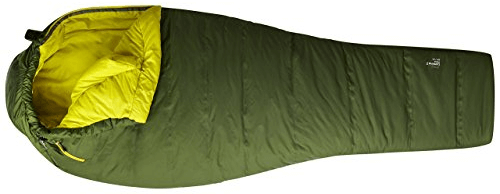
To get the most out of your bag, look for bags with a draft tube that lies against the full length of the zipper, keeping cold air out. Mummy bags also often have insulated collars that wrap around your neck, keeping you even warmer.
Size
When looking for bags, make sure you get the proper-length bag. It should not be too large nor too small but fit you just right. If you get a bag that is too large, your body will have to generate extra heat to warm up the extra space, and small bags are never comfortable.
A good rule of thumb is, if you are 6 feet tall or shorter, a regular-length bag will do. If you are more than 6 feet tall, choose a long bag. If you get a bag that is too short, you risk stretching the bag, flattening the insulation, and making the bag colder.
Temperature Ratings
Temperature ratings can be helpful, but because there is no industry standard, different bags with the same temperature rating may feel different. A bag that is rated for 0 degrees may seem warmer or colder than another bag rated at 0 degrees from a different manufacturer.
Another factor to consider with temperature is that people have different metabolic rates. One person may feel comfortable in a 0-degree bag but may feel cold for another person. What can you do knowing this? Buy a bag that is a little warmer than you think you need. You can also try sleeping in the backyard with various bags before you buy them. There are also some economic options, such as buying sleeping bag liners or adding a thin summer bag to fit inside a 3 season bag. Experiment and find out what you are most comfortable with.
You may also like Differences Between a Summer and Winter Tent
Sleeping bag covers
Most winter sleeping bags are made with a shell material, but having a sleeping bag cover still has its benefits. Sleeping bag covers are waterproof yet breathable, keeping your bag from getting wet and protecting it from the elements. Sleeping bag covers are especially important if you plan on sleeping under the stars without a shelter. This extra layer will keep your bag dry from the outside, and make your bag warmer, as the cover will protect against the wind and add an extra layer of warmth.
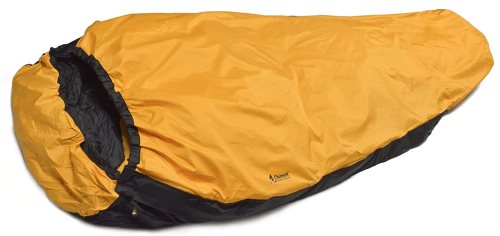
There is one drawback to consider with sleeping bag covers. Normally, water that is expelled from your body passes through the sleeping bad insulation and sometimes condenses on the outside in the form of frost. With a sleeping bag cover, if you’re not careful to brush this frost off every day, the moisture can work its way back into the bag.
Sleeping Pads
Along with a good sleeping bag, another very important part of a winter sleep system should be a sleeping pad. A sleeping pad will not only make sleeping on the ground more comfortable, but it will prevent the ground from stealing valuable body heat.
There are 3 basic types of pads: open-cell air pads, closed-cell foam pads, and self-inflating pads.
Air pads
Air pads must be manually inflated, and offer decent cushion. These are ideal for saving space and backpacking. Some air pads are filled with down feathers to increase insulation. Pump bags are also available to help inflate the pads. Pump bags are manual pumps in the shape of a bag, saving you additional weight and space.
Closed-cell foam pads
Closed-cell foam pads are pads that are light and inexpensive but can be more uncomfortable to sleep on. With a foam pad, you won’t have to worry about air punctures and they can also offer some extra cushion when sitting down. These pads also offer great insulation. They are also decently durable and can take a being without being ripped or torn.
You may also like When Does Camping Gear Go on Sale
Self-inflating Pads
Self-inflating pads are made from open-cell foam that expands in the presence of air. Because of this, they are able to take up less space when deflated, and self-inflate when needed, just like a sponge.
R-value and temperature ratings
When choosing a sleeping pad, pay attention to the R-value. The R stands for resistance and means how resistant the pad is to heat transfer. The more resistant, the less heat transfer there will be between you and the ground.
When camping in cold weather, consider using two sleeping pads. One method is to use a high-R-value air pad or self-inflating pad on top of a closed-cell foam pad. The closed-cell foam pad will offer extra insulation and help protect the inflatable pad from punctures.
Other articles that might interest you:
Photo credit: jalexartis on Visual Hunt / CC BY
